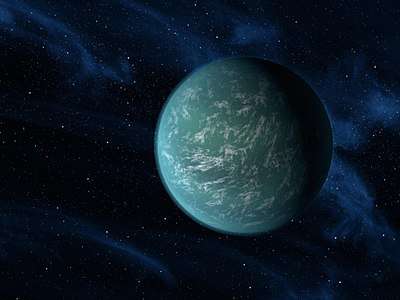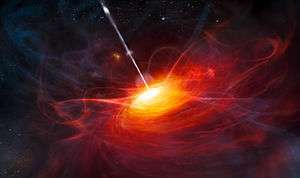Kepler-70
Kepler-70, also known as KIC 5807616 and formerly as KOI-55, is a star in the constellation Cygnus with an apparent visual magnitude of 14.87.[3] This is too faint to be seen with the naked eye; viewing it requires a telescope with an aperture of 40 cm (20 in) or more.[4]
| Observation data Epoch J2000 Equinox J2000 | |
|---|---|
| Constellation | Cygnus[1][note 1] |
| Right ascension | 19h 45m 25.4746s[2] |
| Declination | +41° 5′ 33.8820″[2] |
| Apparent magnitude (V) | 14.87[3] |
| Characteristics | |
| Spectral type | sdB[1] |
| Apparent magnitude (U) | 13.80[3] |
| Apparent magnitude (B) | 14.71[3] |
| Apparent magnitude (R) | 15.43[3] |
| Apparent magnitude (I) | 15.72[3] |
| Apparent magnitude (J) | 15.36[3] |
| Apparent magnitude (H) | 15.59[3] |
| Astrometry | |
| Proper motion (μ) | RA: 7.185±0.061[2] mas/yr Dec.: −3.134±0.060[2] mas/yr |
| Parallax (π) | 0.7850 ± 0.0314[2] mas |
| Distance | 4,200 ± 200 ly (1,270 ± 50 pc) |
| Details | |
| Mass | 0.496 ± 0.002[1] M☉ |
| Radius | 0.203 ± 0.007[1] R☉ |
| Luminosity (bolometric) | 22.9 ± 3.1 L☉ |
| Temperature | 27,730 ± 260[1] K |
| Other designations | |
| Database references | |
| SIMBAD | data |
| KIC | data |
A subdwarf B star, Kepler-70 passed through the red giant stage some 18.4 million years ago. In its present-day state, it is fusing helium in its core. Once it runs out of helium it will contract to form a white dwarf. It has a relatively small radius of about 0.2 times the Sun's radius; white dwarfs are generally much smaller.[5] The star may be host to a planetary system with two planets[6], although later research[7][8] indicates that this is not in fact the case. If they are confirmed to exist, then the innermost planet has the highest temperature of any known planet known so far.
Planetary system
On December 26, 2011, evidence for two extremely short-period planets, Kepler-70b and Kepler-70c, was announced by Charpinet et al.[6] They were detected by the reflection of starlight caused by the planets themselves, rather than through a variation in apparent stellar magnitude caused by them transiting the star.
The measurements also suggested a smaller body between the two confirmed planets; this remains unconfirmed.
If these planets exist, then the orbits of Kepler-70b and Kepler-70c have 7:10 orbital resonance and have the closest approach between planets of any known planetary system. However, later research[7] suggested that what had been detected was not in fact the reflection of light from exoplanets, but star pulsation "visible beyond the cut-off frequency of the star." Further research[8] indicated that star pulsation modes were indeed the more likely explanation for the signals found in 2011, and that the two exoplanets probably did not exist.
| Companion (in order from star) |
Mass | Semimajor axis (AU) |
Orbital period (days) |
Eccentricity | Inclination | Radius |
|---|---|---|---|---|---|---|
| b | 0.440 M⊕ | 0.0060 | 0.2401 | — | 20–80, likely 65 [note 2]° | 0.759 R⊕ |
| KOI-55.03 (unconfirmed) | 0.222 M⊕ | 0.0065 | — | — | — | 0.605 R⊕ |
| c | 0.655 M⊕ | 0.0076 | 0.34289 | — | 20–80, likely 65° | 0.867 R⊕ |
Notes
- This is inferred from the RA and declination of the star.
- inclinations are derived from brightness variations and lack of transits.
References
- "Notes for Planet KOI-55 b". Extrasolar Planet Database. Archived from the original on 19 January 2012. Retrieved 1 January 2012.
- Brown, A. G. A.; et al. (Gaia collaboration) (August 2018). "Gaia Data Release 2: Summary of the contents and survey properties". Astronomy & Astrophysics. 616. A1. arXiv:1804.09365. Bibcode:2018A&A...616A...1G. doi:10.1051/0004-6361/201833051. Gaia DR2 record for this source at VizieR.
- "KPD 1943+4058". SIMBAD. Centre de données astronomiques de Strasbourg. Retrieved 1 January 2012.
- Sherrod, P. Clay; Koed, Thomas L. (2003), A Complete Manual of Amateur Astronomy: Tools and Techniques for Astronomical Observations, Astronomy Series, Courier Dover Publications, p. 9, ISBN 0-486-42820-6
- Cain, Fraser (4 February 2009). "White Dwarf Stars". Universe Today. Retrieved 8 January 2012.
- Charpinet, S.; et al. (December 21, 2011), "A compact system of small planets around a former red-giant star", Nature, 480 (7378): 496–499, Bibcode:2011Natur.480..496C, doi:10.1038/nature10631, PMID 22193103
- Krzesinski, J. (August 25, 2015), "Planetary candidates around the pulsating sdB star KIC 5807616 considered doubtful", Astronomy & Astrophysics, 581
- Blokesz, A.; Krzesinski, J.; Kedziora-Chudczer, L. (4 July 2019), "Analysis of putative exoplanetary signatures found in light curves of two sdBV stars observed by Kepler", Astronomy & Astrophysics, 627


.jpg)